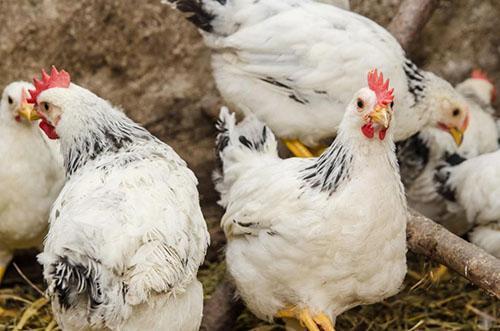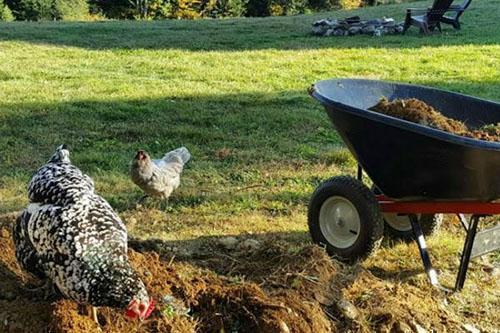10 healthy sources of protein to feed chickens during molting
 During the first molt, chickens shed feathers all over the hen house in such numbers that it can be assumed that a predator has been there. Some birds will molt almost completely at once, while in others the signs of molting may be barely noticeable. Usually, the first change of plumage occurs in chickens in the fall at the age of about 18 months and is faster than subsequent moults. This is an absolutely normal process and there is no reason for concern - the autumn molt indicates that the chickens are preparing for winter.
During the first molt, chickens shed feathers all over the hen house in such numbers that it can be assumed that a predator has been there. Some birds will molt almost completely at once, while in others the signs of molting may be barely noticeable. Usually, the first change of plumage occurs in chickens in the fall at the age of about 18 months and is faster than subsequent moults. This is an absolutely normal process and there is no reason for concern - the autumn molt indicates that the chickens are preparing for winter.
Chickens fluff up their plumage when it gets cold. In this way, they try to keep the air warmed by the body between the surface of the skin and the feathers - this creates a kind of buffer to protect against the cold. If the feathers are old, broken or dirty, the birds cannot fluff them well, so molting just before winter is a guarantee that the chickens will not freeze thanks to the new plumage.

As a rule, chickens get the necessary amount of protein from a quality balanced feed for layers, as well as additional feed that birds usually find themselves - bugs, worms, slugs, grasshoppers, snakes, lizards, frogs. In addition, there are many high-protein plants that can be fed to chickens as a treat all year round, but this is especially beneficial during the fall moult.
 During the plumage season, a small amount of natural protein-rich treats will be very beneficial for chickens, although some advise switching to special foods with a high protein content during this period.
During the plumage season, a small amount of natural protein-rich treats will be very beneficial for chickens, although some advise switching to special foods with a high protein content during this period.
Remember that the number of treats should be limited - no more than 10% of the total diet.
Here's a list of 10 rich sources of protein that I use as a healthy treat for moulting chickens.
Eggs
 Boiled eggs are an extremely rich source of protein, and chickens are also very fond of them. You can, of course, give the birds and raw eggs, but this can lead to unintended consequences, so I still advise you to boil the eggs well for safety.
Boiled eggs are an extremely rich source of protein, and chickens are also very fond of them. You can, of course, give the birds and raw eggs, but this can lead to unintended consequences, so I still advise you to boil the eggs well for safety.
Poultry

Cooked chicken or turkey is also high in protein. You can even give the birds the whole carcass - in the case of chickens, you don't have to worry about choking on shattered bones, as often happens with dogs or cats. You can also treat chickens with offal left over from the turkey after the holiday.
Meat
 Chickens can be given pieces of beef, lamb, pork or bones with meat, as well as offal. The meat can be used raw or cooked. After all, they eat raw meat when they manage to catch small birds or mice.
Chickens can be given pieces of beef, lamb, pork or bones with meat, as well as offal. The meat can be used raw or cooked. After all, they eat raw meat when they manage to catch small birds or mice.
Fish
 Fish in any form - raw, boiled or canned - is a rich source of protein needed by chickens during molting. You can give them a whole fish - along with the head, offal and bones. Chickens love fish very much! Canned tuna or mackerel are also a healthy protein treat.
Fish in any form - raw, boiled or canned - is a rich source of protein needed by chickens during molting. You can give them a whole fish - along with the head, offal and bones. Chickens love fish very much! Canned tuna or mackerel are also a healthy protein treat.
Molluscs
 Shells, meat and insides of lobsters, shrimps, crayfish - raw or boiled.
Shells, meat and insides of lobsters, shrimps, crayfish - raw or boiled.
Mealworms
 Dried mealworms are one of the best sources of complete protein. Chickens are just crazy about them! If you wish, you can grow mealworms at home.
Dried mealworms are one of the best sources of complete protein. Chickens are just crazy about them! If you wish, you can grow mealworms at home.
Nuts and seeds
 Seeds are another rich source of protein. Fresh or dried pumpkin seeds, peeled or inshell sunflower seeds are great options for chickens. Chopped nuts can also be used as a treat - almonds, peanuts, walnuts. Just do not give salted seeds or nuts to chickens.
Seeds are another rich source of protein. Fresh or dried pumpkin seeds, peeled or inshell sunflower seeds are great options for chickens. Chopped nuts can also be used as a treat - almonds, peanuts, walnuts. Just do not give salted seeds or nuts to chickens.
Oats
 Oats can be fed raw or cooked to chickens as a natural protein supplement that birds love. Whole oats and oatmeal are useful.
Oats can be fed raw or cooked to chickens as a natural protein supplement that birds love. Whole oats and oatmeal are useful.
Sprouts
 Sprouted grains and legumes are one of the most favorite treats for chickens, which contain a lot of complete proteins. Beans, peas, lentils are great choices. Growing seedlings is an easy and reliable way to provide your chickens with an additional source of protein.
Sprouted grains and legumes are one of the most favorite treats for chickens, which contain a lot of complete proteins. Beans, peas, lentils are great choices. Growing seedlings is an easy and reliable way to provide your chickens with an additional source of protein.
Chicken feed
 The feed normally fed to chicks during the first eight weeks of life contains much more protein than feed for laying hens. I would not completely replace the diet of adult chickens or layers with it, even during molting. In my opinion, the best option is to add portions from the incomplete chicken feed package (which you probably still have) to the regular feed for molting hens, or mix it with the layer feed.
The feed normally fed to chicks during the first eight weeks of life contains much more protein than feed for laying hens. I would not completely replace the diet of adult chickens or layers with it, even during molting. In my opinion, the best option is to add portions from the incomplete chicken feed package (which you probably still have) to the regular feed for molting hens, or mix it with the layer feed.
Now you know about some of the rich sources of healthy protein for moulting chickens. Don't panic when you see feathers all over the place, just feed your birds regularly with protein supplements.
Another note: I have heard that some people recommend feeding their chickens cat food during molting because it is high in protein. Personally, I do not recommend doing this. Cat food is intended for cats, not chickens. It is better to buy your birds several cans of sardines or other canned fish - it will be not only healthier, but also cheaper!